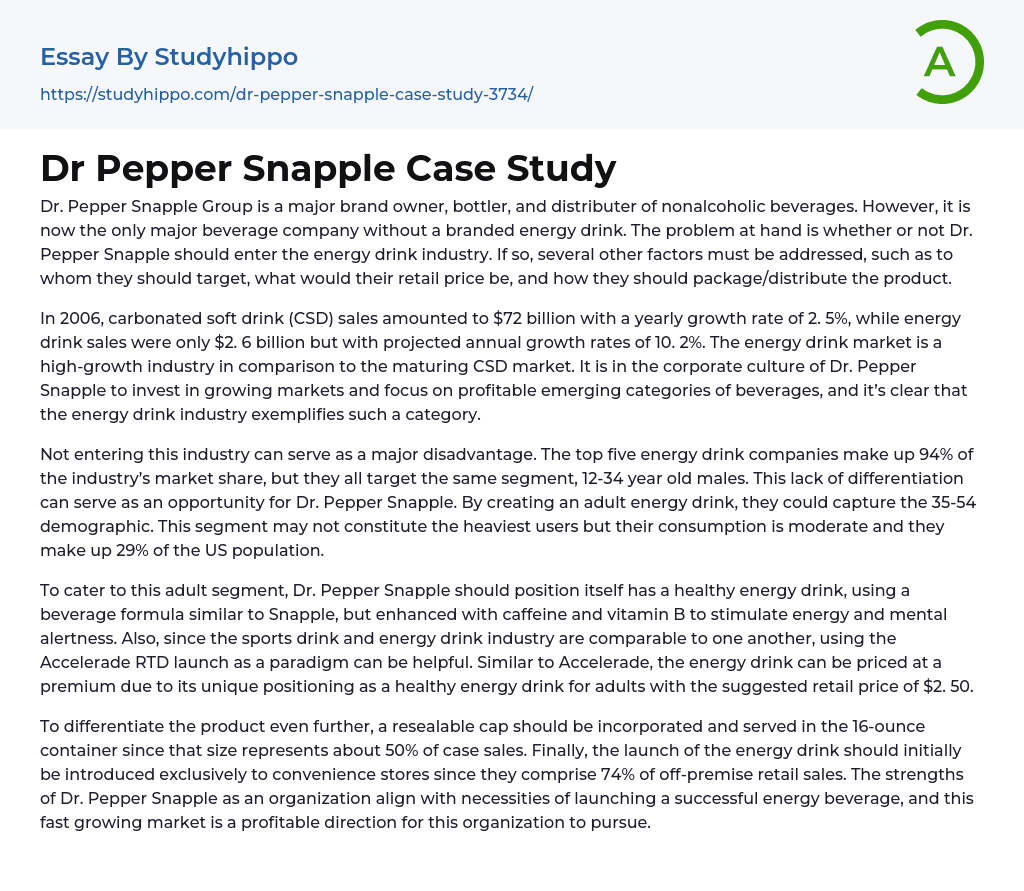Dr. Pepper Snapple Group is a significant player in the nonalcoholic beverage market but differentiates itself from other major beverage companies by lacking an established energy drink offering. The primary decision at hand is whether Dr. Pepper Snapple should venture into the energy drink sector, considering factors like target audience, retail pricing, and packaging/distribution strategies.
The data reveals that in 2006, carbonated soft drink (CSD) sales amounted to $72 billion and experienced a yearly growth rate of 2.5%. Conversely, energy drink sales stood at $2.6 billion with projected annual growth rates of 10.2%. In comparison to the mature CSD market, the energy drink industry is expanding rapidly. Dr. Pepper Snapple places emphasis on investing in flourishing markets and lucrative emerging beverage categories as part of its corporate culture. Consequently, the energy drink sector aligns seamlessly with this busi
...ness approach.
Not entering this industry can be a significant disadvantage. The industry's market share is predominantly controlled by the top five energy drink companies, which collectively account for 94%. However, these companies primarily target 12-34 year old males, resulting in a lack of differentiation. Dr. Pepper Snapple can take advantage of this by creating an energy drink specifically for adults, thereby targeting the 35-54 demographic. Although this segment may not be the heaviest users, their consumption is moderate, and they constitute 29% of the US population.
To target the adult market, Dr. Pepper Snapple should position itself as a nutritious energy drink by adopting a beverage formula reminiscent of Snapple. This formula can be further enriched with caffeine and vitamin B to promote energy and mental agility. Drawing inspiration from the successful launch of Accelerade RTD, which falls under the
sports drink and energy drink industry, Dr. Pepper Snapple can use it as a model. Similar to Accelerade, the energy drink can be priced higher due to its distinctive positioning as a healthy energy drink for adults, with a suggested retail price of $2.50.
In order to further distinguish the product, it is recommended to include a resealable cap and package it in a 16-ounce container, as this size accounts for approximately 50% of case sales. Additionally, the initial launch of the energy drink should be limited to convenience stores, which make up 74% of off-premise retail sales. The strengths of Dr. Pepper Snapple as a company align with the requirements for successfully introducing an energy beverage, and this rapidly expanding market offers a lucrative opportunity for the organization to pursue.
- Chief Executive Officer essays
- Convenience Store essays
- Firm essays
- Training And Development essays
- Unilever essays
- Variable Cost essays
- Virgin Group essays
- Bargaining essays
- Entity essays
- Pest analysis essays
- John Locke essays
- 9/11 essays
- A Good Teacher essays
- A Healthy Diet essays
- A Modest Proposal essays
- A&P essays
- Academic Achievement essays
- Achievement essays
- Achieving goals essays
- Admission essays
- Advantages And Disadvantages Of Internet essays
- Alcoholic drinks essays
- Ammonia essays
- Analytical essays
- Ancient Olympic Games essays
- APA essays
- Arabian Peninsula essays
- Argument essays
- Argumentative essays
- Art essays
- Atlantic Ocean essays
- Auto-ethnography essays
- Autobiography essays
- Ballad essays
- Batman essays
- Binge Eating essays
- Black Power Movement essays
- Blogger essays
- Body Mass Index essays
- Book I Want a Wife essays
- Boycott essays
- Breastfeeding essays
- Bulimia Nervosa essays
- Business essays
- Business Process essays
- Canterbury essays
- Carbonate essays
- Catalina de Erauso essays
- Cause and Effect essays
- Cesar Chavez essays




